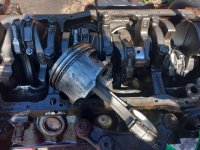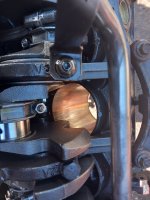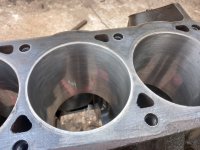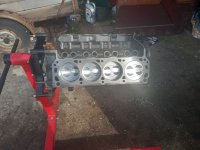It turned out that only the rings for cyl#1 were tight, all the others were above the general 4thou per inch ring gap advice, most cylinders had 18thou ring gap low in the cylinders to 20thou near the tops of cylinders - probably due to cylinders tapering toward the bottom by a couple of thou.
I have installed all the pistons (and obviously all the rings). But I have a nagging doubt that I didn't measure/gap one of the oil rings on #1 so I intend on removing that piston and rings to check all the ring gaps. Also I got bored of filing rings for #1 and ended up using an angle grinder to make the job quicker but made the mistake of taking too much of the 2nd ring making the gap way too large (like 25thou +)... So I used another new 2nd ring when installing #1 and left the too wide ring2 for the last piston I installed which was #2. Instead of fitting the too wide ring on #2 I refitted an old 2nd compression ring but I'm not happy with that either. So I'll be removing both #1 and number #2 pistons... I'll be checking the gaps on #1 and maybe increasing the gap on one of it's oil rings, and will be buying a new set of rings to fit just one of the 2nd rings on #2. I'm on holiday (vacation) from Sunday for 10 days so I'll order new rings 7 or 8 days into the holiday so arrival will coincide with my return.
At least as it stands the engine turns over easily by using a small lever on the rear crank (to flywheel) bolts with all pistons installed. But I know that re-using rings (for #2 ) is too much of a compromise even if it is just for the 2nd ring and continuing doubt about oil ring gap on #1 would be worse than simply removing and rechecking/adjusting gap while the bottom end is still in a state where doing such things is still easy.
I've ordered a new timing light and magnetic base dial gauge - I'll use the dial gauge to find true TDC and make sure timing marks (which I couldn't see before, maybe painted too thickly over) on the harmonic balancer match up perfectly to the pointer (which is currently bent but I'll make it point to the TDC mark on the balancer or add my own marks to the balancer if I can't see any after stripping paint).
Lots of other things (none boat related) to do tomorrow but one thing boat related I do intend on doing is checking the hydraulic trim. When I first bought the boat the outdrive was holding at full tilt on the hydraulics but the hydraulic trim didn't seem to work properly on the river... and when I came to pull the boat out of the water on the slipway (so lifted the leg fully on the hydraulics) it slowly came back down, I had to strap the leg up before I could tow the boat on the road on the trailer. With the engine out I have a better view of the hydraulic pump system and it seems that there's a slight leak from where one of the hydraulic lines connects to the pump. I hope to be able to tighten that (leaking) union to prevent the leak, and then I hope the hydraulic system will be fixed when I've added more ATF/PAS (what shall I refill the trim pump with?) fluid.
It won't stop there even when I've rebuilt and reinstalled the engine and fixed the trim! The bilge pump is broken, plastic pipe stub snapped off right at the pump, no worries for a few days on the river at a time but I'll want to fix that for use on the sea. The only gauges that work on the dash are speedo (usual marine lack of accuracy), trim maybe, rev counter maybe, echo sounder depth. The oil pressure gauge doesn't work at all.
For the purpose at least of rudimental engine testing and running in I'll want a working oil pressure gauge. The existing marine setup seems to have an oil pressure sender unit for the dash gauge and an open/closed sender for the oil pressure alarm. I don't know whether to try to utilise the existing pressure sender to wire to a separate electronic gauge (until I've fixed the dash gauge) or connect a purely mechanical oil pressure gauge in the engine bay... What are your thoughts? I'm not sure if these oil pressure senders are a standard spec (voltage or resistance according to oil pressure) or are designed to work with a certain dash gauge. For immediate purposes I would be happy with an adhoc electronic or mechanical gauge in the engine bay... But I do need a working oil pressure gauge particularly during run-in.
I'm wary of making this post too long but so far it's been mostly an update on progress with only a few questions, so I'll risk making this thread a bit longer and air a few more thoughts, So far I'm still in the process of rebuilding this engine, some drawbacks of the marine setup are coming to light - The block is '96, heads are '95 but the timing cover, water pump and inlet manifold are more like '73 cast iron spec. That kind of setup is limiting - If it were not for the marine spec stuff I could otherwise drop any 302 in and it work well with no concerns about raw water damaging the head gasket, inlet, water pump, etc. I could buy fully assembled (with valves etc) aluminium heads for £900 which might add (say) 100bhp at 5500rpm with the standard (marine) cam but I could only go that route without suffering corrosion problems if I switched to a closed cooling system for the engine. I could maybe buy a used marine heat exchanger from a 7.4L diesel V8 inboard engine for (say) £200 and adapt the simple plumbing to make it work with the 302. Then I could use any 302, wouldn't matter about what year (or material) the water pump or inlet was made from, could run a late spec multi-plane inlet. What are your thoughts on doing that? Not sure if my '95 block would work with an OEM '95 roller cam setup (the marine spec with 95 block uses flat hydraulic system)... not that I could run much more cam duration anyway (don't want to suffer reverse flow and suck water into cylinders) but the roller cam could give gains at higher rpm and wouldn't need it's own running in procedure that is at odds with best practice running in procedure for other engine components? As it stands I don't need to worry about running in a cam or bearings because I just reused existing (relatively new and in good condition) bearings, but if I were to build a new engine with new cam best practice as far as the cam was concerned would differ from best practice as far as the rings and bores were concerned. Heh, it building a new engine it would probably be better to fit an old cam first until the rings were seated, then fit the new cam.



























